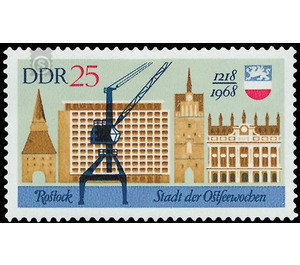750 years Rostock - Germany / German Democratic Republic 1968 - 25 Pfennig
Theme: Architecture
| Country | Germany / German Democratic Republic |
| Issue Date | 1968 |
| Face Value | 25.00 |
| Color | multi-colored |
| Perforation | K 14 |
| Printing Type | Photogravure |
| Stamp Type | Postage stamp |
| Item Type | Stamp |
| Chronological Issue Number | 1127 |
| Chronological Chapter | GER-DDR |
| SID | 484614 |
| In 12 Wishlists | |
Rostock - City of the Baltic Sea Weeks The Ministry of Posts and Telecommunications of the German Democratic Republic issues for Rostock, the city of the Baltic Sea weeks, two multicolored special postage stamps. In 1968, the 11th Baltic Week takes place. At the same time, the city is celebrating its 750th anniversary. Rostock - City of the Baltic Sea Weeks On the occasion of the 11th Baltic Sea Weeks and the 750th anniversary of the city of Rostock, two special postage stamps and a first day cover envelope are issued. The series is supplemented with a special cancellation. The two special postage stamps show distinctive buildings from the medieval and modern Rostock under the coat of arms with symbols of the most important economic sectors of the city, the sea and port economy. 25-pfennig value Only a few of the historical monuments have survived the fires and war-fires. Among them is the town hall on today's Ernst-Thälmann-Platz, of which only the central building with the characteristic, much-sung seven towers is depicted. The core of this building looks back on an age of over 700 years, however, the Baroque intent was added only in the 18th century. Next to it we see the largest and most important of the Rostock city gates, the Kröpeliner Tor, which dates back to the first half of the 14th century. On the six floors of this gate, a permanent exhibition on the city's history will be compiled until the town's anniversary. Among the new landmarks of the city of Rostock is the eleven-story building of the Schiffahrt, built in 1963, the seat of the German Maritime Company and the Maritime and Port Authority, in Langen Straße. The series is completed by the stone gate, which we already met in the historical presentation. The tower, which was destroyed during the Second World War, was rebuilt in 1954 as part of monument preservation. The stone gate is used by the museum, which keeps here in particular the archive of the history of the Rostock workers movement. Both gates, the Kröpeliner Tor and the Steintor, border the old city center, the city center. As a counterpart to the Hansekogge in the historical view, a harbor crane rises in front of the house of shipping. He points to the role of Rostock as the largest port city of the GDR and can at the same time symbolize the second great heyday in the 750-year history of the city, the epoch of socialist construction interpret. The Rostock coat of arms shows on a shield in the Hansefarben blue-white-red in the blue field the "Vagel Grip", the Rostock Griffin, a union of the two royal animals lion and eagle. The walking griffin was already, as the traditional seals prove, the emblem of Heinrich Borwin I, the founder of the city of Rostock. As a symbol of the city of Greif appears for the first time in 1307th The year 1218-1968 indicate the 750th anniversary of the city. The city of Rostock was awarded the city right on June 24, 1218. Every year since 1958, the Baltic Sea region of Rostock, with the strong participation of peace-loving forces from the Baltic States, has been conducting the Baltic Sea Week under the slogan "The Baltic Sea - A Sea of Peace". The policy of the GDR is aimed at making the Baltic Sea a sea of peace and a nuclear-weapon-free zone and to improve and deepen the economic and cultural relations between the GDR and all the Baltic States. Central to the Baltic Sea Week is the port, shipyard and university city of Rostock, which has taken a huge economic boost in the past two decades as a result of the generous expansion of the overseas port and the expansion and expansion of industry. The ships built in the Warnow shipyard and the shipyard "Neptune" announce the diligence and skill of its inhabitants. In addition to shipbuilding and fish processing, general mechanical engineering is steadily increasing and Rostock is increasingly becoming a thriving city under socialist conditions.


